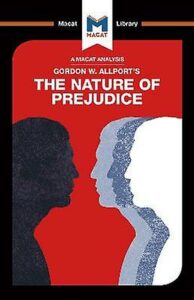Share
Allport, G. W. (1954). The Nature of Prejudice. Doubleday.
Aron, A., McLaughlin-Volpe, T., Mashek, D., Lewandowski, G., Wright, S. C., & Aron, E. N. (2004). Including others in the self. European Review of Social Psychology, 15(1), 101‑132. https://doi.org/10.1080/10463280440000008
Britt, T. W., Bonieci, K. A., Vescio, T. K., Biernat, M., & Brown, L. M. (1996). Intergroup Anxiety : A Person × Situation Approach. Personality and Social Psychology Bulletin, 22(11), 1177‑1188. https://doi.org/10.1177/01461672962211008
Capozza, D., Falvo, R., Trifiletti, E., & Pagani, A. (2014). Cross-group Friendships, Extended Contact, and Humanity Attributions to Homosexuals. Procedia – Social and Behavioral Sciences, 114, 276‑282. https://doi.org/10.1016/j.sbspro.2013.12.698
Cikara, M., Bruneau, E. G., & Saxe, R. R. (2011). Us and Them : Intergroup Failures of Empathy. Current Directions in Psychological Science, 20(3), 149‑153. https://doi.org/10.1177/0963721411408713
Cole, C. F., Arafat, C., Tidhar, C., Tafesh, W. Z., Fox, N. A., Killen, M., Ardila-Rey, A., Leavitt, L. A., Lesser, G., Richman, B. A., & Yung, F. (2003). The educational impact of Rechov Sumsum/Shara’a Simsim : A Sesame Street television series to promote respect and understanding among children living in Israel, the West Bank, and Gaza. International Journal of Behavioral Development, 27(5), 409‑422. https://doi.org/10.1080/01650250344000019
Croucher, S. M. (2017). Integrated Threat Theory. Oxford Research Encyclopedia of Communication. https://doi.org/10.1093/acrefore/9780190228613.013.490
Dovidio, J. F., Eller, A., & Hewstone, M. (2011). Improving intergroup relations through direct, extended and other forms of indirect contact. Group Processes & ; Intergroup Relations, 14(2), 147‑160. https://doi.org/10.1177/1368430210390555
Dovidio, J. F., Johnson, J. D., Gaertner, S. L., Pearson, A. R., Saguy, T., & Ashburn-Nardo, L. (2010). Empathy and intergroup relations. Prosocial motives, emotions, and behavior : The better angels of our nature., 393‑408. https://doi.org/10.1037/12061-020
Finlay, K., & Stephan, W. G. (1999). The Role of Emphaty In Improving Intergroup Relations. Journal of Social Issues, 55(4), 729‑743.
Fourie, M. M., Subramoney, S., & Madikizela, P. G. (2017a). A Less Attractive Feature of Empathy : Intergroup Empathy Bias. Empathy – An Evidence-based Interdisciplinary Perspective. https://doi.org/10.5772/intechopen.69287
Gavosto, A., Venturini, A., & Villosio, C. (1999b). Do Immigrants Compete with Natives ? Labour, 13(3), 603‑621. https://doi.org/10.1111/1467-9914.00108
Harwood, J. (2017). Indirect and Mediated Intergroup Contact. The International Encyclopedia of Intercultural Communication, 1‑9. https://doi.org/10.1002/9781118783665.ieicc0161
Hewstone, M., Lolliot, S., Swart, H., Myers, E., Voci, A., al Ramiah, A., & Cairns, E. (2014). Intergroup contact and intergroup conflict. Peace and Conflict : Journal of Peace Psychology, 20(1), 39‑53. https://doi.org/10.1037/a0035582
Jasinskaja-Lahti, I., Mähönen, T. A., & Liebkind, K. (2011). Ingroup norms, intergroup contact and intergroup anxiety as predictors of the outgroup attitudes of majority and minority youth. International Journal of Intercultural Relations, 35(3), 346‑355. https://doi.org/10.1016/j.ijintrel.2010.06.001
Lienemann, B. A., & Stopp, H. T. (2013). The association between media exposure of interracial relationships and attitudes toward interracial relationships. Journal of Applied Social Psychology, 43, E398‑E415. https://doi.org/10.1111/jasp.12037
Mazziotta, A., Mummendey, A., & Wright, S. C. (2011a). Vicarious intergroup contact effects. Group Processes & ; Intergroup Relations, 14(2), 255‑274. https://doi.org/10.1177/1368430210390533
Pagotto, L., & Voci, A. (2013). Direct and mass-mediated contact : the role of different intergroup emotions. TPM, Vol. 20(4), 365‑381. https://doi.org/10.4473/TPM20.4.5
Paolini, S., Harwood, J., & Rubin, M. (2010). Negative Intergroup Contact Makes Group Memberships Salient : Explaining Why Intergroup Conflict Endures. Personality and Social Psychology Bulletin, 36(12), 1723‑1738. https://doi.org/10.1177/0146167210388667
Paolini, S., Hewstone, M., Cairns, E., & Voci, A. (2004). Effects of Direct and Indirect Cross-Group Friendships on Judgments of Catholics and Protestants in Northern Ireland : The Mediating Role of an Anxiety-Reduction Mechanism. Personality and Social Psychology Bulletin, 30(6), 770‑786. https://doi.org/10.1177/0146167203262848
Pettigrew, T. F. (2010). Deprovincialization. Encyclopedia of Peace Psychology, 1‑6.
Pettigrew, T. F., Christ, O., Wagner, U., & Stellmacher, J. (2007). Direct and indirect intergroup contact effects on prejudice : A normative interpretation. International Journal of Intercultural Relations, 31(4), 411‑425. https://doi.org/10.1016/j.ijintrel.2006.11.003
Pettigrew, T. F., & Tropp, L. R. (2008). How does intergroup contact reduce prejudice ? Meta-analytic tests of three mediators. European Journal of Social Psychology, 38(6), 922‑934. https://doi.org/10.1002/ejsp.504
Pettigrew, T. F., Tropp, L. R., Wagner, U., & Christ, O. (2011). Recent advances in intergroup contact theory. International Journal of Intercultural Relations, 35(3), 271‑280. https://doi.org/10.1016/j.ijintrel.2011.03.001
R. (2018, 4 avril). Biais de confirmation : nous croyons ce que nous voulons croire. A man in the arena. https://amaninthearena.com/biais-de-confirmation/
Schiappa, E., Gregg, P. B., & Hewes, D. E. (2005). The Parasocial Contact Hypothesis. Communication Monographs, 72(1), 92‑115. https://doi.org/10.1080/0363775052000342544
Schmid, K., Hewstone, M., Küpper, B., Zick, A., & Tausch, N. (2013). Reducing aggressive intergroup action tendencies : Effects of intergroup contact via perceived intergroup threat. Aggressive Behavior, 40(3), 250‑262. https://doi.org/10.1002/ab.21516
Stephan, W. G. (2014). Intergroup Anxiety. Personality and Social Psychology Review, 18(3), 239‑255. https://doi.org/10.1177/1088868314530518
Stephan, W. G., & Stephan, C. W. (1985). Intergroup Anxiety. Journal of Social Issues, 41(3), 157‑175. https://doi.org/10.1111/j.1540-4560.1985.tb01134.x
Stephan, W. G., Ybarra, O., & Bachman, G. (1999). Prejudice Toward Immigrants1. Journal of Applied Social Psychology, 29(11), 2221‑2237. https://doi.org/10.1111/j.1559-1816.1999.tb00107.x
Stürmer, S., & Snyder, M. (2009). Helping “Us” versus “Them”. The Psychology of Prosocial Behavior, 33‑58. https://doi.org/10.1002/9781444307948.ch2
Supplemental Material for Reducing Intergroup Prejudice and Conflict Using the Media : A Field Experiment in Rwanda. (2009). Journal of Personality and Social Psychology. https://doi.org/10.1037/a0011989.supp
Telaku, M. (2021). Intergroup Contact, Intergroup Anxiety, and Attitudes towards the Opposing Group in Divided Society. Psihologijske teme, 30(3), 397‑420. https://doi.org/10.31820/pt.30.3.1
Tropp, L. R., & Wright, S. C. (2001). Ingroup Identification as the Inclusion of Ingroup in the Self. Personality and Social Psychology Bulletin, 27(5), 585‑600. https://doi.org/10.1177/0146167201275007
Vezzali, L., Hewstone, M., Capozza, D., Giovannini, D., & Wölfer, R. (2014). Improving intergroup relations with extended and vicarious forms of indirect contact. European Review of Social Psychology, 25(1), 314‑389. https://doi.org/10.1080/10463283.2014.982948
Vezzali, L., Stathi, S., & Giovannini, D. (2012a). Indirect contact through book reading : Improving adolescents’ attitudes and behavioral intentions toward immigrants. Psychology in the Schools, 49(2), 148‑162. https://doi.org/10.1002/pits.20621
Vezzali, L., Stathi, S., & Giovannini, D. (2012b). Indirect contact through book reading : Improving adolescents’ attitudes and behavioral intentions toward immigrants. Psychology in the Schools, 49(2), 148‑162. https://doi.org/10.1002/pits.20621
Wright, S. C., Aron, A., McLaughlin-Volpe, T., & Ropp, S. A. (1997a). The extended contact effect : Knowledge of cross-group friendships and prejudice. Journal of Personality and Social Psychology, 73(1), 73‑90. https://doi.org/10.1037/0022-3514.73.1.73
Wright, S. C., Aron, A., McLaughlin-Volpe, T., & Ropp, S. A. (1997b). The extended contact effect : Knowledge of cross-group friendships and prejudice. Journal of Personality and Social Psychology, 73(1), 73‑90. https://doi.org/10.1037/0022-3514.73.1.73
Wright, S. C., Aron, A., McLaughlin-Volpe, T., & Ropp, S. A. (1997c). The extended contact effect : Knowledge of cross-group friendships and prejudice. Journal of Personality and Social Psychology, 73(1), 73‑90. https://doi.org/10.1037/0022-3514.73.1.73



Average Rating